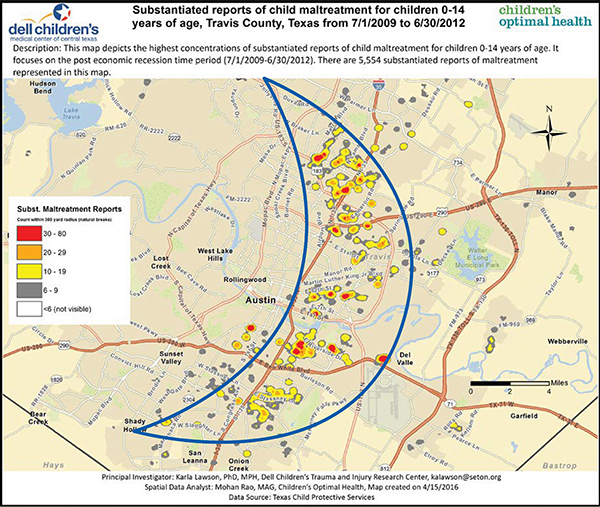By GAIL APPLESON
The color purple can bring to mind a variety of things: a prize-winning book; the hue of royalty; or even the description of some wines. But for the researchers at Dell Children's Medical Center of Central Texas, it refers to an important program aimed at preventing abusive head trauma in babies.
The Austin hospital's education program is based on what is known as "The Period of PURPLE Crying," when babies are apt to cry for long stretches. These challenging times can lead parents to forcefully shake or strike a child to stop the wailing. This kind of violence can cause abusive head trauma, also known as shaken baby syndrome, in which a child can suffer permanent brain injury or death.

Duzinski
In response, Dell Children's, which is part of the Seton Healthcare Family, launched a PURPLE crying education program to help parents cope with this challenging time. The program was initially offered in two of Seton's six birthing hospitals and there are plans to roll it out to the others.
The program is part of "multipronged efforts to combat child maltreatment, both at the hospital and the community level," said Sarah Duzinski, former associate director of programs and evaluation at Dell Children's Trauma and Injury Research Center.
Duzinski spearheaded the PURPLE crying education program. She has taken a position outside the ministry and will transition the program to a new employee at Dell Children's. Duzinski said the program grew out of the realization that the hospital was treating about two cases of abusive head trauma each month and that there were some 600 emergency room visits annually based primarily on infant crying.
"About one quarter of children who are shaken die," she said. "Those that survive often suffer serious health issues and only 10 to 11 percent are able to go on and live a normal life."
In addition, she pointed out, parents under the age of 20 are five times more likely to shake their babies.

Child advocates reacted to this data map showing a high concentration of child abuse east of Austin, Texas, by alerting school districts of the need to train teachers to recognize and respond to abuse and trauma in their students. The map was published in “Upstream: Mapping a pathway to end child maltreatment,” a community report produced by Dell Children’s Medical Center of Central Texas in collaboration with Children’s Optimal Health.
Turning Texas purple
As a result, Duzinski began to explore existing programs aimed at helping parents understand when to expect these crying jags, how to control their own behavior and when and how to get support.
Her search ended when she found "The Period of PURPLE Crying" program developed by the National Center on Shaken Baby Syndrome. This prevention program, which is based on more than 30 years of research, provides tools and resources to hospitals and other health care organizations to help them educate parents and caregivers. (See below.)
"We want them to know the crying isn't caused because you're a bad parent or your child is a bad baby," Duzinski said. "We want them to understand that 'my baby is in the purple crying period and it won't last.'"
In 2013, the program was introduced at Seton Medical Center Williamson and the next year at University Medical Center Brackenridge. (Brackenridge will be replaced by the new Dell Seton Medical Center at The University of Texas.)
"We were the first hospital system in Austin to offer the program, and it would be great if other hospitals provided it as well," Duzinski said. "We're hoping to turn all of Texas purple."
Hotspotting child abuse
Duzinski is also a key member of the Dell Children's team that developed a data mapping report that identifies Austin's hot spot areas for child abuse and maltreatment. Since last summer, Dell Children's researchers have been sharing the information with community organizations that can provide counseling, intervention and other preventive measures aimed at combatting maltreatment. A summit with those organizations was held in July.
"The idea is to get all related agencies to play their part," Duzinski said.
The report, called "Thinking Upstream: Mapping a Pathway to End Child Maltreatment," is based on information Dell Children's researchers obtained from the Texas Department of Family and Protective Services. The data came from substantiated reports of child maltreatment in the three years before the Great Recession, a period from Dec. 1, 2004, to Nov. 30, 2007, and from three years after the recession's end, a period from July 1, 2009, to June 30, 2012. The study, which involved children zero to 14 years of age, was comprised of reports for all types of maltreatment including neglectful supervision, physical abuse, sexual abuse, abandonment, refusal of parental rights, emotional abuse, medical neglect, and physical neglect.
Dell Children's researchers also worked with geographic information system experts at Children's Optimal Health to create maps showing trends in child maltreatment and areas most affected by child abuse.
The SAFE Alliance is among the organizations responding to the report. (SAFE stands for stop abuse for everyone.) SAFE, a nonprofit human services agency, was created by the merger of the Austin Children's Shelter and SafePlace. Its mission is to lead in ending sexual assault and exploitation, child abuse, and domestic violence through prevention, intervention, and advocacy for change.
Barbara Ball, the director of evaluation and training of a SAFE Alliance program called Expect Respect, said the mapping data showed a substantial incidence of child maltreatment in communities to the east of Austin.
Ball said she has been sharing the information with school districts in these communities so that they can take appropriate actions including training teachers to recognize trauma and work with affected students; bring in social workers when needed and apply for grants to obtain funding for additional support services and prevention programs.
"This is an incredibly important planning tool for the school districts to have," she said.
|
Center provides resources to prevent shaken baby syndrome
“The Period of PURPLE Crying” program, available through the nonprofit National Center on Shaken Baby Syndrome, has been implemented in more the 2,000 organizations globally to date and that number increases weekly, according to Julie Noble, international program director.
The organization, based in Farmington, Utah, does not charge hospitals and other organizations for the online training they provide to their nurses, doctors and other providers. There is also no charge for the technical service and support.
Noble said there is a cost for the program materials: DVD/booklet, $2.30 each, per package, per family; and web and mobile application/booklet, $2 each, per package, per family.
The Period of PURPLE Crying program helps parents and caregivers understand the frustrating aspects of infant crying that can lead to abuse. The word “period” in the title means that the crying has a beginning and end and the individual letters in PURPLE are defined in the box below.
— GAIL APPLESON
|
Copyright © 2017 by the Catholic Health Association
of the United States
For reprint permission, contact Betty Crosby or call (314) 253-3490.